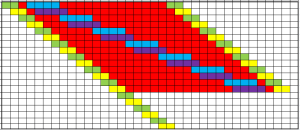 Flow improvement-by-design requires being able to see the flows; and that is trickier than it first appears.
Flow improvement-by-design requires being able to see the flows; and that is trickier than it first appears.
We can see movement very easily.
Seeing flows is not so easy – particularly when they are mixed-up and unsteady.
One of the most useful tools for visualising flow was invented over 100 years ago by Henry Laurence Gantt (1861-1919).
Henry Gantt was a mechanical engineer from Johns Hopkins University and an early associate of Frederick Taylor. Gantt parted ways with Taylor because he disagreed with the philosophy of Taylorism which was that workers should be instructed what to do by managers (=parent-child). Gantt saw that workers and managers could work together for mutual benefit of themselves and their companies (=adult-adult). At one point Gantt was invited to streamline the production of munitions for the war effort and his methods were so successful that the Ordinance Department was the most productive department of the armed forces. Gantt favoured democracy over autocracy and is quoted to have said “Our most serious trouble is incompetence in high places. The manager who has not earned his position and who is immune from responsibility will fail time and again, at the cost of the business and the workman“.
Henry Gantt invented a number of different charts – not just the one used in project management which was actually invented 20 years earlier by Karol Adamieki and re-invented by Gantt. It become popularised when it was used in the Hoover Dam project management; but that was after Gantt’s death in 1919.
The form of Gantt chart above is called a process template chart and it is designed to show the flow of tasks through a process. Each horizontal line is a task; each vertical column is an interval of time. The colour code in each cell indicates what the task is doing and which resource the task is using during that time interval. Red indicates that the task is waiting. White means that the task is outside the scope of the chart (e.g. not yet arrived or already departed).
The Gantt chart shows two “red wedges”. A red wedge that is getting wider from top to bottom is the pattern created by a flow constraint. A red wedge that is getting narrower from top to bottom is the pattern of a policy constraint. Both are signs of poor scheduling design.
A Gantt chart like this has three primary uses:
1) Diagnosis – understanding how the current flow design is creating the queues and delays.
2) Design – inventing new design options.
3) Prognosis – testing the innovative designs so the ‘fittest’ can be chosen for implementation.
These three steps are encapsulated in the third “M” of 6M Design® – the Model step.
In this example the design flaw was the scheduling policy. When that was redesigned the outcome was zero-wait performance. No red on the chart at all. The same number of tasks were completed in the same with the same resources used. Just less waiting. Which means less space is needed to store the queue of waiting work (i.e. none in this case).
That this is even possible comes as a big surprise to most people. It feels counter-intuitive. It is however an easy to demonstrate fact. Our intuition tricks us.
And that reduction in the size of the queue implies a big cost reduction when the work-in-progress is perishable and needs constant attention [such as patients lying on A&E trolleys and in hospital beds].
So what was the cost of re-designing this schedule?
A pinch of humility. A few bits of squared paper and some coloured pens. A couple hours of time. And a one-off investment in learning how to do it. Peanuts in comparison with the recurring benefit gained.

3 Replies to “Seeing-by-Doing”